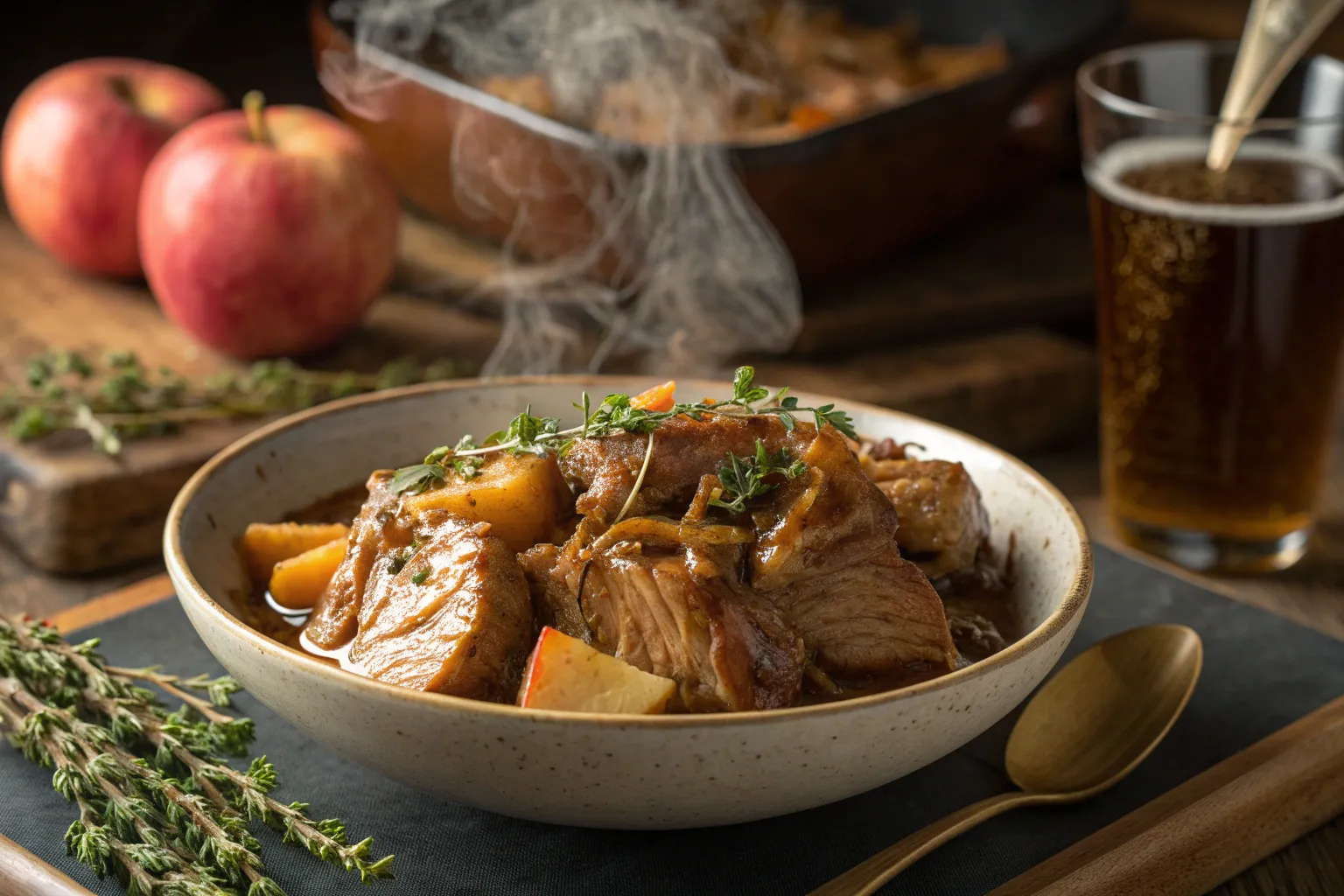Apple Cider Braised Pork Shoulder – Tender & Flavorful Pork Roast

When it comes to comfort food that feels both rustic and gourmet, few dishes compare to a perfectly braised pork shoulder. This apple cider braised pork shoulder is a tender, flavorful roast that pairs the richness of slow-cooked pork with the sweet and tangy notes of apple cider. Perfect for fall gatherings, Sunday dinners, or even a cozy holiday meal, this recipe is one that will impress every guest at the table.
Why You’ll Love This Recipe
Braised pork shoulder is the ultimate blend of hearty and comforting. The apple cider not only tenderizes the meat as it cooks low and slow but also infuses it with a subtle sweetness that balances beautifully with herbs, onions, and garlic. It’s a recipe that requires minimal active work but delivers incredible results—juicy, pull-apart pork with a flavorful sauce you’ll want to drizzle over everything.
Ingredients You’ll Need
Before you begin, it’s helpful to gather everything in one place. This recipe uses simple pantry staples and fresh herbs to build layers of flavor. From the pork shoulder to the apple cider and aromatic herbs, each ingredient has a role in creating the perfect balance of tenderness and taste.
- 4–5 lbs pork shoulder (bone-in or boneless)
- 2 cups apple cider (not apple cider vinegar)
- 1 cup chicken or vegetable broth
- 2 large onions, sliced
- 4 cloves garlic, minced
- 2 tbsp olive oil
- 2 tbsp tomato paste
- 2 tbsp apple cider vinegar (optional, for brightness)
- 2–3 sprigs fresh rosemary (or 1 tsp dried)
- 2–3 sprigs thyme (or 1 tsp dried)
- 2 bay leaves
- Salt and black pepper, to taste
Step-by-Step Instructions

Cooking a pork shoulder may sound intimidating, but this process couldn’t be easier. By breaking it down into simple steps, from searing to braising, you’ll see just how approachable this dish really is. Every stage builds flavor, ensuring that the end result is worth the wait.
1. Sear the Pork
Season the pork shoulder generously with salt and pepper. Heat olive oil in a large Dutch oven over medium-high heat. Sear the pork on all sides until golden brown, about 3–4 minutes per side. Remove and set aside.
2. Build the Flavor Base
In the same pot, add sliced onions and cook until softened. Stir in garlic and tomato paste, cooking for another minute until fragrant.
3. Deglaze & Add Liquids
Pour in apple cider to deglaze the pan, scraping up any browned bits. Add broth, vinegar (if using), rosemary, thyme, and bay leaves.
4. Braise the Pork
Return the pork to the pot, cover with a lid, and transfer to a preheated oven at 325°F (165°C). Braise for 3–4 hours, or until the pork is fork-tender and pulls apart easily.
5. Finish & Serve
Remove the pork from the pot. Skim excess fat from the braising liquid, then simmer it for 5–10 minutes to thicken into a sauce. Shred the pork and serve with the cider sauce drizzled on top.
Ingredient Swaps & Variations
Recipes should work for you, not the other way around. If you don’t have a certain ingredient on hand, or want to add your own twist, there are plenty of options. Whether you switch up the herbs, experiment with different broths, or even try a beef roast instead, this dish adapts beautifully.
- Swap apple cider with pear cider for a unique twist.
- Add carrots and parsnips into the braise for a built-in side dish.
- Use hard cider instead of apple cider for a more robust flavor.
- Substitute pork shoulder with beef chuck roast for a hearty beef version.
Serving Suggestions

The beauty of a braised pork shoulder lies in its versatility. It can be served over creamy sides, paired with vegetables, or shredded into sandwiches. No matter how you present it, this roast is hearty enough to shine as the centerpiece of any table.
- Serve over mashed potatoes to soak up the rich sauce.
- Pair with buttered egg noodles or rice for a hearty dinner.
- Add a side of roasted root vegetables for a complete fall meal.
- Shred leftovers for sandwiches or sliders with coleslaw.
Storage & Reheating Tips
One of the best parts about making a large roast is the leftovers. With the right storage, you can enjoy this meal for days or even freeze portions for later. Reheating properly ensures the pork stays juicy and flavorful, just like when it first came out of the oven.
- Refrigerator: Store in an airtight container for up to 4 days.
- Freezer: Shredded pork can be frozen for up to 3 months.
- Reheat: Warm gently in a skillet with a splash of broth or cider to keep it moist.
Common Mistakes to Avoid
Even the simplest recipes can go wrong without a few pointers. From using the wrong type of cider to skipping the sear, these little mistakes can impact the flavor and texture. Keeping these tips in mind will help you get the best results every time.
- Skipping the sear: This step builds flavor and should never be skipped.
- Using apple cider vinegar instead of cider: They are not the same and will drastically change the taste.
- Not skimming fat: Pork shoulder is fatty; skimming ensures a cleaner, more balanced sauce.
- Overcooking at high heat: Low and slow is the secret to tender pork.
Chef’s Special Tips
Sometimes, the smallest adjustments take a recipe from good to unforgettable. A splash of bourbon, a pat of butter, or preparing the dish a day in advance can elevate both flavor and presentation. These insider tips will help you make the dish uniquely your own.
- For an extra glossy sauce, whisk in a tablespoon of cold butter at the end.
- If serving for a crowd, braise a day ahead—flavors deepen overnight.
- Add a splash of bourbon or brandy with the apple cider for a rich, warming note.
Conclusion
This Apple Cider Braised Pork Shoulder is everything a comforting roast should be; juicy, flavorful, and full of cozy aromas. With simple ingredients and a little patience, you’ll have a dish that feels like it came from a restaurant kitchen, perfect for family dinners or holiday feasts. Try it once, and it just might become your new favorite way to cook pork shoulder.

